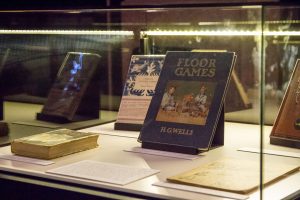Thomas Fisher Library renovation aims to prevent condensation

GEREMY BORDONARO/GLEANER NEWS: Thomas Fisher’s rare books are now safe from condensation thanks to student ingenuity.
By Geremy Bordonaro
It’s home to a diverse array of rare manuscripts, and the archives of some our nation’s most prominent scribes. Even as the HMS Terror lies under the Arctic sea, its log books are safely stored within its walls.
Opened in 1973 and a fixture of the University of Toronto’s St. George campus, the Thomas Fisher Rare Book Library has long had a fatal flaw. Condensation has occurred on the inner walls of the library’s mezzanine levels, threatening the integrity of the library’s collection. But an eye-catching exterior renovation, now underway, is addressing the problem.
“We realized some years ago that this was obviously a serious problem for a rare book library”—P. J. Carefoote, librarian
“The building [is] 40 to 45 years old and in between the inner and the outer wall there was a vapour barrier. Over the years that barrier disintegrated,” said librarian P. J. Carefoote. “That meant that condensation was building up on the inside and it wasn’t being absorbed. We realized some years ago that this was obviously a serious problem for a rare book library.”
He explained the devastating effects of heavy moisture on the rare books if the condensation continued to build up.
“The things that books dislike most of all is fluctuations in humidity and temperature. When you have moisture build-up on the inside there’s a danger that humidity levels are going to go up. When humidity levels go up there’s a danger of mould,” said Carefoote. “Once a book gets mould the treatment is very, very costly, if possible at all.”
Dealing with the problem has proved to be difficult.
All architectural firms suggested the library move all of the books out and close for interior renovations, something out of the question for the library’s manager, John Toyonaga, manager of the library.
“To move that many books, rare books, is a task in itself. Where do you move them to? They can’t just go anywhere,” said Toyonaga. “[They’ve] got to go to a controlled environment. And then if people want to use them they need to be accessible. That is the whole issue why we wouldn’t want to [take] that route. And we didn’t have to.”
It was a group of University of Toronto students who came up with a solution.
“You can give [the university] a problem and [it] groups first year students to come up with options for you. No charge,” he said. “I saw this ad and I went up to my supervisor and said, ‘You know we’ve got nothing to lose. Let’s see what they can come up with.’”
Although the solution has changed considerably from what the students proposed, the group did spark an idea that led to the current work.
“We looked at ways to increase the temperature of the exterior walls. That can be done in a few different ways,” said Jack Albert of RJC Engineers: Structural Engineering, Building Science & Restoration. “The way that it’s being done now avoids the necessity of moving the books. That was one of the big owner concerns.”
RJC has installed purple and yellow layered insulation, and it already appears to be working.
It has also drawn some new eyes to the building.
“The best thing about this is that people at large have noticed that we’re here, which is great. After 40 years, people are starting to realize that there’s a rare book library in Toronto,” said Carefoote. “Oddly enough, having our building turn purple and then turn yellow has really brought it to people’s attention. People have been coming in. It’s a nice side benefit to all this.”
READ MORE:
ABOUT OUR COVER: Arctic amusements (December 2016)
ARTS: HMS Terror found on greeting cards (December 2016)
ABOUT OUR COVER: A red house in winter (December 2015)
